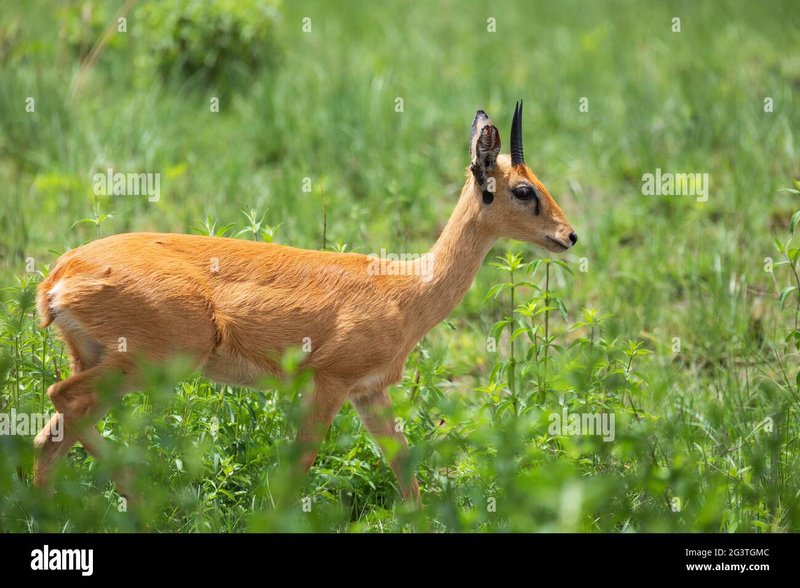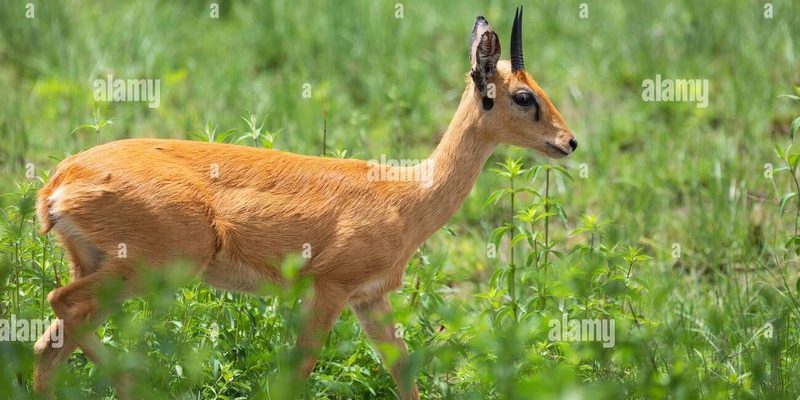
So, what exactly makes the Oribi so special? Let’s dive into its world and explore how it interacts with both its environment and the other creatures that share its home. Understanding the Oribi’s role helps us appreciate the intricate web of life found in its ecosystem and highlights the importance of conserving these unique animals.
What is an Oribi?
First off, let’s get to know our subject. The Oribi, or *Ourebia ourebi*, is a small antelope native to eastern and southern Africa. Standing about 70 to 90 cm tall at the shoulder and weighing between 10 to 20 kg, it’s not the biggest animal on the block. Its coat is a warm tan, often lightening to a creamy white underneath. The Oribi is also distinguished by its long, slender legs and elegant long neck, helping it spot predators from afar.
You might wonder how the Oribi fits into the larger picture of its environment. Well, this little antelope is a herbivore, meaning it primarily eats grasses and leaves. It’s a picky eater, favoring young shoots that are high in nutrients. By grazing selectively, the Oribi helps to control plant growth, which can influence the types of vegetation in its habitat and support a diverse range of other species.
The Oribi’s Diet and Foraging Behavior
Now, let’s talk about what the Oribi eats and how it goes about finding food. This antelope primarily consumes a diet rich in grasses, but it doesn’t just munch away without a plan. The Oribi has evolved to prefer certain types of grasses, especially tender, nutrient-rich young shoots. This selectivity not only benefits their health but also helps regulate the plant life in their ecosystem.
When foraging, Oribis exhibit fascinating behavior. They often graze in small groups, keeping an eye out for predators like lions or hyenas. It’s as if they’re holding a little meeting to decide which patch of grass to tackle next! By staying alert and alerting each other to danger, they foster a community-focused approach to survival.
Through their feeding habits, Oribis indirectly support other species. By keeping grasslands at optimal lengths, they contribute to a balance that encourages various plant and animal life, ensuring that both predators and prey can thrive.
The Role of Oribis in the Food Chain
Oribis are more than just grazers; they play a significant role in the food chain. As herbivores, they are a food source for larger predators. When an Oribi is taken down by a predator, it’s not just a single meal—it’s part of the cycle of life that helps keep populations of both prey and predator in check. This interconnectedness is key to maintaining ecosystem health.
On the flip side, Oribis also face threats from larger carnivores. Their agility and quick reactions help them escape most of the time, but they are constantly adapting to their environment. This ongoing challenge means that the Oribi’s presence can help shape predator behavior and hunting strategies, leading to a balanced relationship between various species in the ecosystem.
Additionally, by influencing predator populations, Oribis help promote biodiversity. Healthy predator-prey interactions result in varied populations of other wildlife, creating a more stable and resilient environment.
Habitat and Social Structure
Oribis usually prefer open grasslands, woodlands, and savanna environments, where they can easily spot danger. Their preferred habitats provide the right balance of cover and forage, making it easy for them to blend in with their surroundings. Think of their coat as nature’s camouflage, allowing them to stay hidden from prying eyes.
Socially, Oribis are somewhat unique. They tend to be solitary or found in pairs, unlike many other antelope species that form larger herds. This social structure offers them a couple of advantages. For one, it minimizes competition for food; less competition means they can easily find those tender shoots they adore. Also, when in pairs, Oribis can take turns watching for predators, which enhances their survival chances.
This special social dynamic demonstrates how the Oribi has adapted to its environment. It shows that, in the wild, not every creature needs to conform to a herd mentality to thrive.
Adaptations for Survival
Adaptation is a fascinating concept in nature. The Oribi has evolved several traits that help it survive in the wild. For example, its long legs allow it to sprint away from threats quickly, while its keen eyesight enables it to spot potential dangers from afar. Think of the Oribi as nature’s little parkour expert, nimbly dodging danger with style.
Moreover, their coloration isn’t just for aesthetics. The tan coat blends seamlessly with the golden grasses of the savanna, making it harder for predators to spot them. This natural camouflage is a key survival tactic, demonstrating how the Oribi has adapted to its environment over time.
Even their foraging habits are a form of adaptation. By grazing selectively and at different times during the day, Oribis can avoid competing with other herbivores and reduce their chances of being spotted by predators.
The Importance of Conservation
With all of these roles in their ecosystem, it’s clear that Oribis are vital. Unfortunately, they face threats from habitat loss, hunting, and climate change, leading to concerns about their conservation status. Protecting the Oribi means safeguarding the delicate balance of their ecosystem.
Conservation efforts focus on preserving their habitats and raising awareness about their importance. Many wildlife reserves now work to create environments where Oribis can thrive. By protecting these spaces, we’re not just saving the Oribi; we’re also protecting countless other species that depend on a healthy ecosystem.
Honestly, every little effort counts. When we support conservation initiatives, we are not only helping Oribis but the entire web of life that exists alongside them.
The Oribi might be small, but its role in the ecosystem is anything but insignificant. From controlling plant growth to serving as prey for larger predators, this little antelope is a key player in the health of its habitat. By understanding and appreciating the Oribi’s contributions, we can better advocate for conservation and the protection of biodiversity.
So next time you think about the mighty African savanna, remember the graceful Oribi and its dance through the grasslands. It’s not just a pretty face; it’s a vital part of the ecosystem that helps keep our world in balance. Let’s do our part to ensure that the Oribi—and all its fellow inhabitants—continue to thrive for generations to come.

